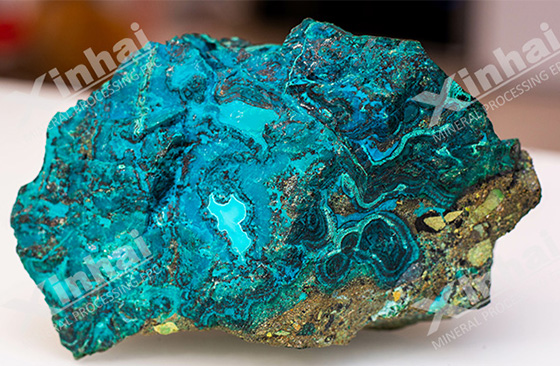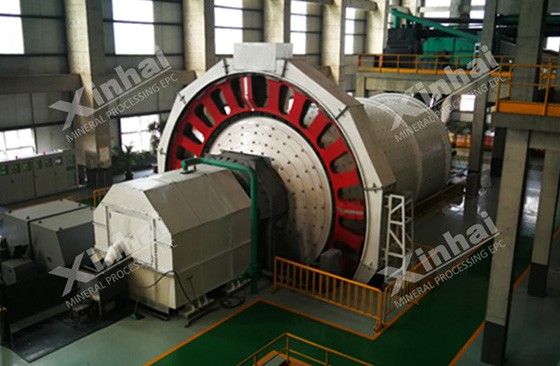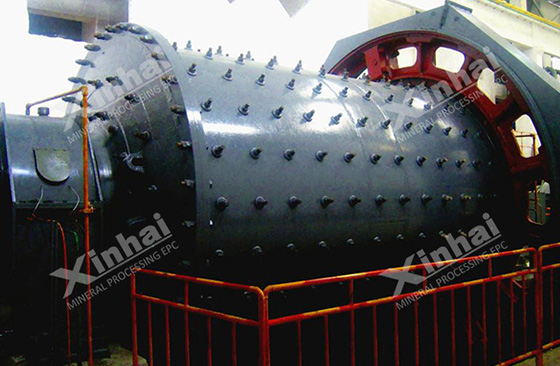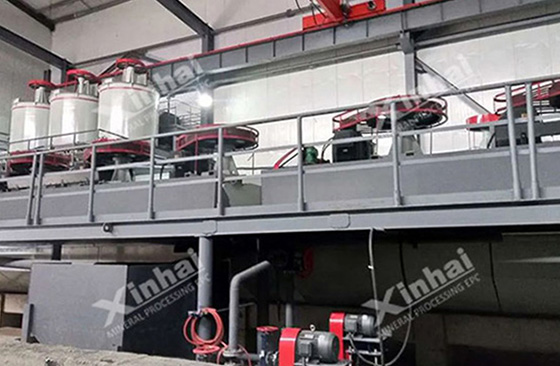
One of the main beneficiation methods of porphyry copper ore is flotation separation. There are some problems encountered in flotation. In this paper, the problems that may be encountered in the flotation of porphyry copper ore are discussed in terms of mineral differences and beneficiation factors.
Mainly reflected in several aspects: clay and other slimes, excessive pyrite content, oxidized or activated pyrite, different copper sulfide ores, ore type variability, etc., as detailed below:

1. Clay and other slimes: The ore comes with native slimes, which are difficult to reduce by improving the process. However, the amount of secondary slime produced by grinding, screening and other processes can be reduced by some means, such as changing the structure and operation of the ball mill and improving the operation of the coarse flotation tank. The flotation effect of porphyry copper ore mainly depends on the grinding fineness and the properties of gangue minerals. The fine-grained slime produced by excessive grinding has an adsorption effect on the mineral surface and can inhibit sulfide. The change of the physical properties of the pulp will have an important impact on the flotation effect.
2. Excessive pyrite content: Flotation of ores containing chalcopyrite pyrite is more difficult mainly because the floatability of these minerals is similar. When separating these ores, a large amount of lime or cyanide needs to be added, and heating is required during the sorting. In order to improve the recovery rate of concentrate, flotation suppression is carried out on the pyrite, so the pyrite content of the medium ore is increased. For medium ore recovery, the cycle load increases and the carbon slurry cycle time is prolonged.
3. Oxidized or activated pyrite: Pyrite is oxidized or activated by copper ions, and the selective separation of copper sulfide and pyrite is difficult. With the increase of mining depth in open-pit mines, the problem of pyrite activation is easy to solve.

4. Different copper sulfide minerals: The change of copper mineral composition in the ore often affects the flotation kinetic factors, which in turn affects the recovery effect of flotation and the grade of the concentrate. The higher the content of secondary copper minerals in the ore, the higher the grade of the flotation concentrate. Xanthate can be used in flotation of copper ore, which has high flotation efficiency and low cost, and can be applied to most mineralized minerals.
5. Variability of ore type: The change of ore is mainly caused by the composition of minerals, the grade of raw ore, the degree of oxidation and the degree of crystallization. Changes in the ore type will further affect its beneficiation indicators. The control factors of ore flotation beneficiation index are dissociation particle size and the relative flotation rate of individual particles and particle groups. The relative flotation efficiency of copper sulfide minerals is generally changed by controlling the chemical environment of the flotation pulp or the physical environment of the flotation froth phase. In order to improve the beneficiation index, it is necessary to control the flotation process of sulfide ore.
The influencing factors of beneficiation are divided into: grinding characteristics, flotation kinetics, unsuitable reagents, grinding media and so on.

1. Grinding characteristics: ore in different parts of different mines will have different dissociation characteristics. During the grinding process, the grinding circuit is controlled by the particle size rather than the degree of dissociation, so the grinding circuit cannot adapt to these changes. If during flotation, the particle size of the ore fed to the ore is not suitable, it will produce too much flotation ore, which will lead to low flotation efficiency. Therefore, the grinding characteristics of the ore itself should be understood during flotation.
2. Flotation kinetics: the main minerals in porphyry copper ore are chalcopyrite, pyrite, and non-sulfide gangue, and these types of ores have significantly different flotation kinetic speeds. For example, the flotation speed of chalcopyrite is faster than that of pyrite during roughing or concentration, so in theory most of the pyrite is easily suppressed and enters the tailings. However, gangue minerals, pyrite and non-sulfide minerals will also be naturally floated or brought into the foam layer along with the medium ore particles and then enter the concentrate. Changes in flotation conditions and changes in the ore surface will produce changes in the flotation kinetics. The result is a decrease in chalcopyrite flotation rate and an increase in pyrite flotation rate.
3. Unsuitable reagents: the reagents used to treat porphyry copper ore are simple and in small quantities, but to improve the flotation index, it is necessary to find a suitable combination of reagents. In actual production, one of the main reasons affecting the recovery rate of flotation is the change of ore mineral composition. In order to eliminate the impact of this change in flotation, it is necessary to adjust the flotation agent and the amount added. When chalcopyrite and pyrite are separated, the effect of xanthate addition rate on the flotation effect is very significant.

4. Grinding medium: grinding medium affects the beneficiation index mainly through two mechanisms: one is the formation of corrosion current between sulfide minerals and iron, resulting in electrochemical corrosion; the other is that the internal fracture of the particles causes the mineralized particles to fracture laterally, and then produces Lots of fines. When dealing with sulfide ore, ball mills and rod mills can be used for grinding before flotation.

The above contents are the problems that may be encountered during flotation of porphyry copper ore, and there are other influencing factors in actual production. In order to determine the appropriate copper ore beneficiation process and improve the beneficiation standard, the beneficiation test before beneficiation is very necessary. Through the test results, the formulation of a beneficiation plan can improve the recovery rate of concentrate ore and the utilization rate of resources. Xinhai Mining can provide you with a one-stop service for copper ore beneficiation from beneficiation test to equipment installation and commissioning. If necessary, please leave a message for consultation.
To find out more about our products and solutions, please fill out the form below and one of our experts will get back to you shortly.